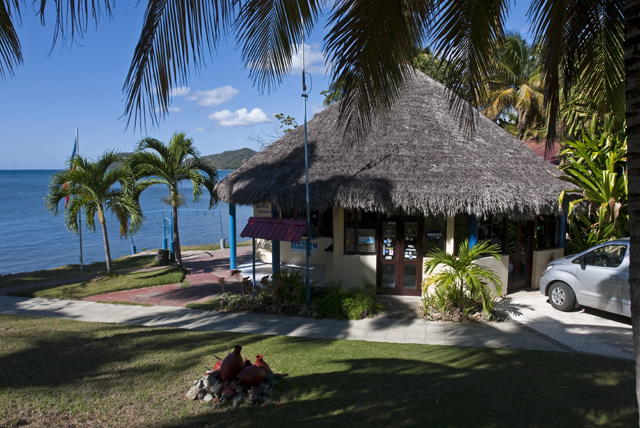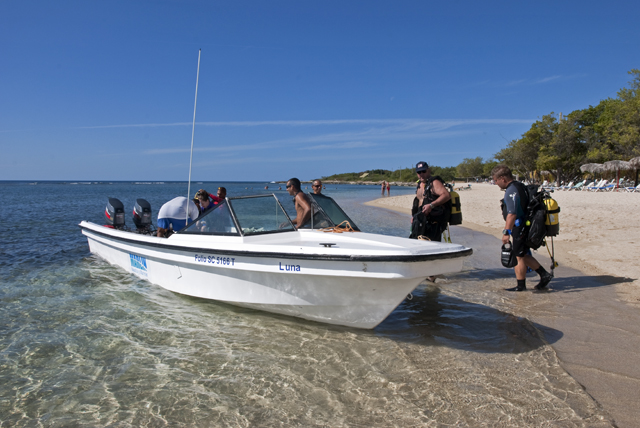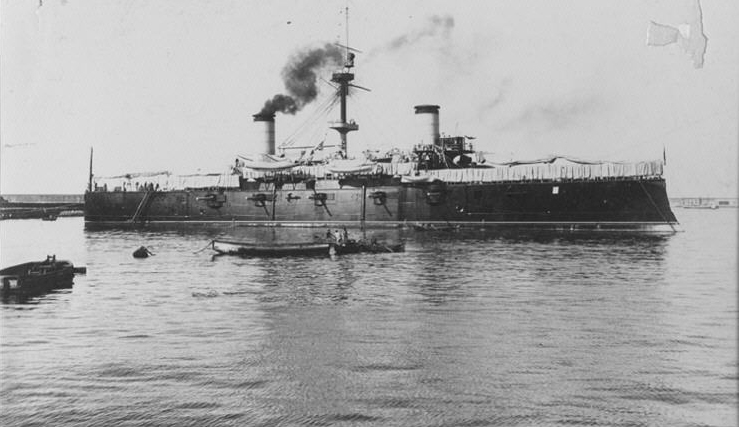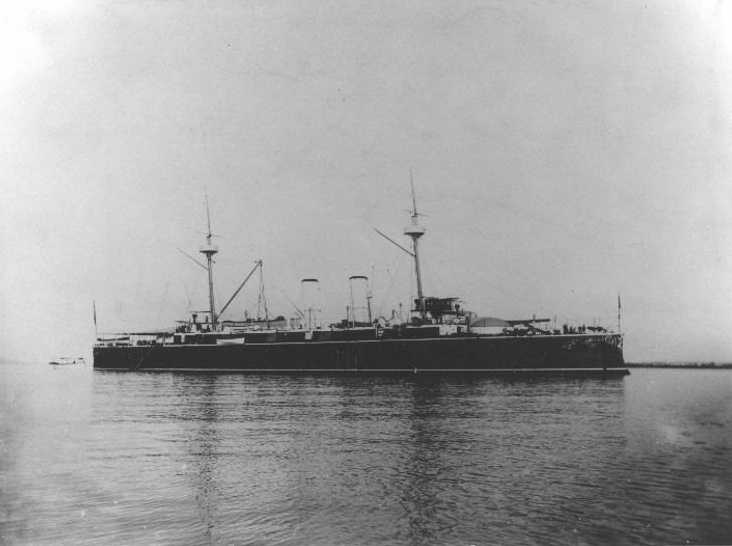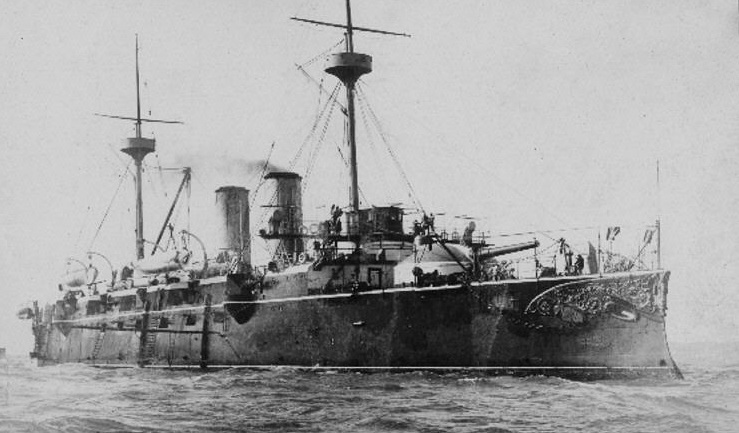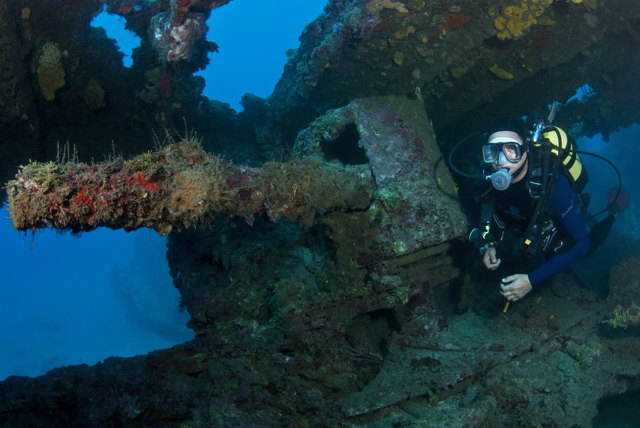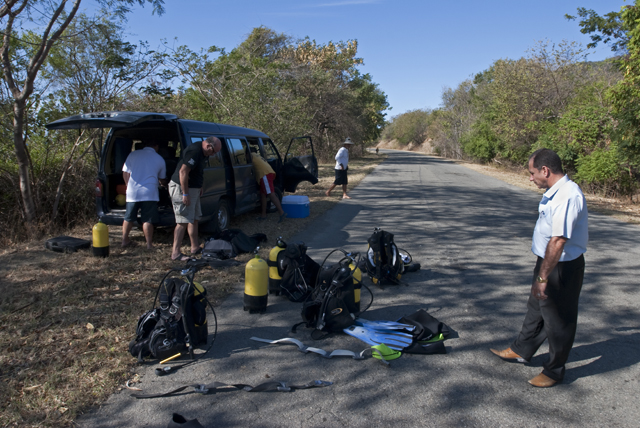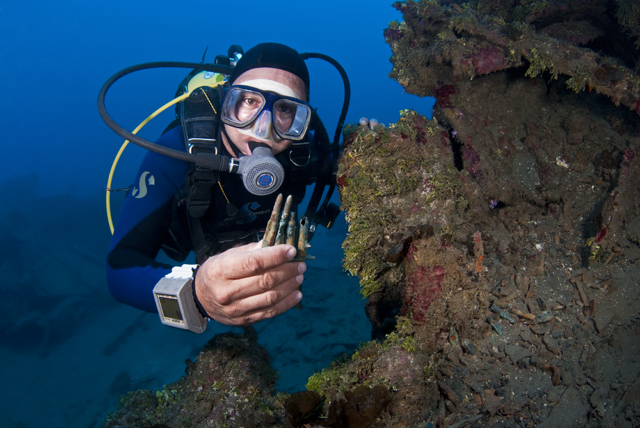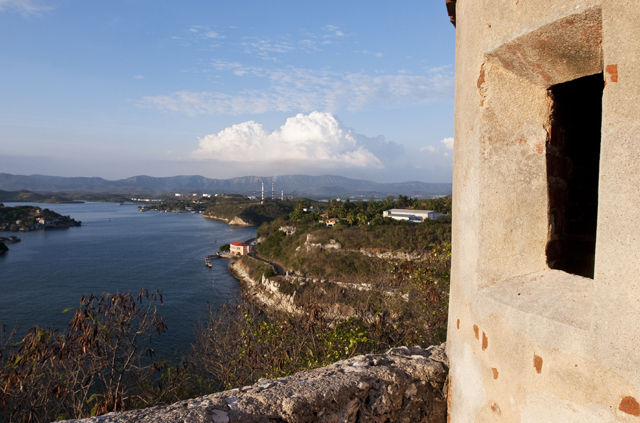News
The wrecks of the Battle of Santiago
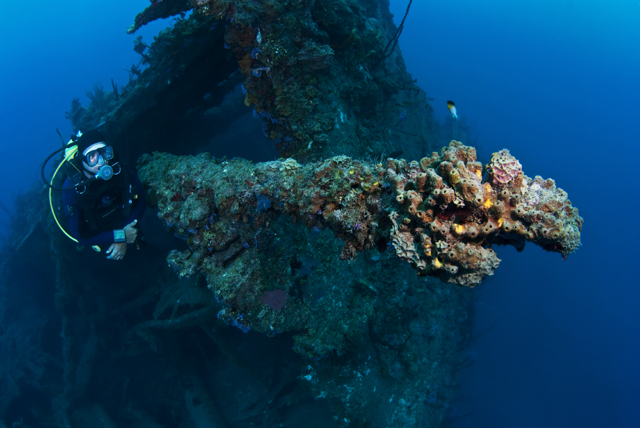
I’m always on the lookout for exciting new wreck dives, but I didn’t expect to find 4 historical warships all sunk in the same sea battle! I had spotted a poster promoting the American-Spanish civil war wrecks on the Cuba Tourism stand at the dive show, but when I investigated further no one seemed to offer any dedicated diving trips and I couldn’t find much information on the internet.
By Cuban standards the great sea battle at Santiago de Cuba was their equivalent to Scapa Flow or Truk Lagoon, so what was the problem? After spending more than a century underwater maybe there just wasn’t anything left to see? I spoke with John Spencer-Ades, the owner of The Scuba Place, and firmed up plans for a full on exploratory expedition just to find out what was actually lying on the seabed.
John contacted Marlin dive centres and they recommended that I stay at Santiago for the first leg of my trip and then transfer up the coast to Guama for the final stages. Unfortunately the whole week turned out to be a fruitless exercise. Most of the wrecks are located near river mouths so the heavy summer rainfall obliterates the sites with murky water. When I spoke to the dive centre manager, Julian Bosch, he recommended a visit during the drier winter months and said he could normally guarantee crystal clear conditions. It was really frustrating to see the huge 11 inch (280mm) guns towering above the waterline and not be able to get any decent underwater pictures. I spent the rest of my time diving on a number of modern day freighters and passenger ferries located to the east of Santiago Bay, but that’s another story.
A few months later I returned with John and his friend Bruce Milani. As before, I based myself at the 5-star Melia Hotel. This was approx 20 minutes drive from the dive centre at Santiago Harbour. I stuck with my original plan to re-trace the entire sea battle starting with the wreck of the Collier Merrimac, located in the middle of Santiago bay.
Admiral Pascual Cervera Y Topete had set sail for the Caribbean with 6 Spanish warships.
Upon hearing this grave news, America mobilised the entire fleet. The North Atlantic Squadron commanded by Rear Admiral William T Sampson and the Flying Squadron commanded by Commodore Winfield Scott Sibley was ordered to hunt down and sink the Spanish warships. Several tense weeks passed by without a single sighting, and then they were spotted lying at anchor in Santiago Bay. Rear Admiral Sampson ordered an immediate blockade of the harbour entrance. Julian said the Americans attempted to stop Cervera’s Squadron from leaving the harbour by blocking the exit. The 98m long US Collier Merrimac was scuttled in the main channel but unfortunately the steering gear was damaged by gunfire and the ship drifted out of position before it sank.
The Merrimac is located just 5 minutes speed boat ride from the dive centre at a maximum depth of 20 metres. It’s only possible to dive the wreck on an incoming tide due to the amount of sediment that comes out of the harbour. The first few metres of the descent are virtually ‘pea soup’ with zero visibility. Due to the wrecks position smack bang in the middle of the harbour entrance there’s also the possibility of overhead boat traffic. Once I got through the ‘fog’ layer visibility increased to around 10-15 metres but the water had a strange fluorescent green tinge and it was still quite dark owing to the overhead silt layer. A torch is essential and some careful finning required owing to the fact that the bottom composition is made up of fine sediment. There also seemed to be a growing population of Lionfish on the wreck.
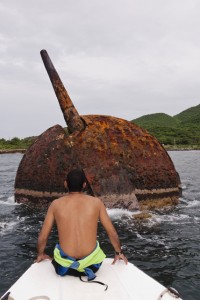
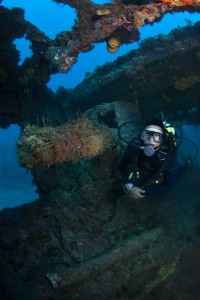 Although most of the topside structure has collapsed there is still plenty to explore. The stern area seems to be more intact with the massive propeller being the main feature. Julian showed me the huge anchor lying half buried in the sand around 10 metres off the starboard side stern. The cargo holds are still full of coal and there are portholes, anchor chains, bollards and winches to look at. I found plenty of small shoals of fish swimming about, and jellyfish are quite common.
Although most of the topside structure has collapsed there is still plenty to explore. The stern area seems to be more intact with the massive propeller being the main feature. Julian showed me the huge anchor lying half buried in the sand around 10 metres off the starboard side stern. The cargo holds are still full of coal and there are portholes, anchor chains, bollards and winches to look at. I found plenty of small shoals of fish swimming about, and jellyfish are quite common.
Although Cervera felt relatively safe holed up inside the harbour the Cuban Government wouldn’t assist with any repair work to his ships. After a 37 day stale-mate Cervera received news that US land forces were rapidly advancing on his position. This left the veteran Admiral only 2 options; either surrender or make a break for it. At 9-00am on Sunday 3rd July 1898, when the Americans were busy with religious services, he gave orders to up anchor and leave the bay.
The ships came out in single file on a westerly heading. Cervera’s flagship, Infanta Maria Teresa was in the lead followed by armed cruisers Cristobal Colon, Almirante Oquendo and Vizcaya. The general idea was to hug the coastline until they got past the American warships and then make a dash for the open sea. Earlier that morning some of the American ships including the flagship USS New York had left position to rendezvous with US land forces. This had left a gap in the blockade line.
Lookouts spotted the Spanish ships and sounded battle stations. Armed Cruiser USS Brooklyn engaged the lead ship Infanta Maria Teresa. Cervera’s brave plan was to draw fire so that the rest of his squadron could escape. The 111m long (7,000 ton) flagship, bombarded by shells, eventually caught fire and ran aground. Most of the crew escaped and swam safely ashore including the Admiral. I’m not quite sure what happened to the wreck of the infant Maria Teresa. Julian said he had found some wreckage close to shore but nothing really substantial. I did find some reference to a salvage operation, so maybe that was the ship’s fate?
Armed Cruiser Almirante Oquendo managed to get slightly further along the coast before receiving a barrage of direct hits from USS Iowa. The stricken ship changed course and was scuttled in the shallows. The wreck is approximately 1 hour speed boat ride from the dive centre. I could see the huge deck guns pointing skywards way before we reached the site. The circular bow turret is almost completely out of the water. The stern turret is submerged and only the barrel breaks the surface. Julian had already warned me that the prevailing cold front would make surface conditions quite choppy but I wasn’t prepared for the same murky conditions underwater, in fact it was slightly worse than the summer time. I finned along the entire length of the hull to the deepest point at about 10 metres but conditions didn’t get any better. Most of the super structure is a mass of twisted metal but I could still identify the massive boilers, a row of port holes and the main mast. I also found plenty of reef fish, morays and lobsters milling about.
Vizcaya had an hour long battle with USS Brooklyn and was reported to have been hit around 200 times. A huge explosion forced the ship inshore where she eventually ran aground. This site is approximately 2.5 hours by speedboat from the dive centre. The bow turret also breaks the surface but this time the aft gun and turret lie upside down on the seabed. Unfortunately the underwater conditions were just as disappointing as the Oquendo. Most of the structure is covered in soft corals making it very difficult to differentiate wreck from reef. I managed to wriggle inside the upturned turret and take a look at the guns firing mechanism but there wasn’t much else to penetrate. For me the best ‘lost’ picture opportunity was the giant turret mounting wheel, which standing vertically, reminded me of a ‘Stargate’. I could picture a diver swimming through the metal ring, torch in hand, but alas it wasn’t to be on this trip.
The 2 Destroyers Pluton and Furer tried to escape by turning east. But they were shelled by USS Iowa, USS Indiana and eventually by USS New York. On receiving news of the battle, Flagship USS New York had turned around and come back. Furor was sunk and Pluton ran aground and blew up. Julian said there was nothing of any significance left to see.
The Cristobal Colon managed to break away from the pursuing American warships. The 112m long (8000 ton) Italian built ship was a new second generation cruiser. With a top speed of 20 knots she was easily the fastest ship in the Spanish squadron. But Captain Emilio Diaz Moreu had a number of concerns. Firstly the ship had been dispatched to Cuba without her full armament. The main 10 inch gun was missing. For show a dummy wooden gun had been fitted to the mounting. Secondly the supply of high grade British coal, fuelling the furnaces, was about to run out. The low quality coal remaining would not allow them to maintain their current speed. This meant that the US ships would eventually catch them up. USS Oregon managed to fire 2 shots across Colon’s stern. In Captain Moreu’s mind this was far too close for comfort. He gave the order to open the stop cocks and scuttle the ship.
The wreck of the Colon was way beyond the range of Julian’s speedboat. John made arrangements for us to stay at the 3.5-Star Brisas Sierra Mar Hotel located approximately 2 hours (60km’s) taxi-drive from Santiago at a place called Guama. We spent a night at the Hotel and then in the morning travelled another 2 hours by minivan to the shore diving site. I spoke to Edgar, the Hotel’s dive centre manager, before we left and he said ‘there’s a cold front coming’. From past experiences I already knew that this meant another bout of strong winds and unsettled seas. Not ideal conditions for photography or for that matter a shore dive. As we drove along the coast road I could see a coffee coloured ‘dirty water’ slick oozing from the shallows blending with clearer blue water about 200 – 300 metres out to sea. Edgar said not to worry all would be okay but my scepticism was rising fast.
Edgar said that the wreck used to be a popular dive site up until Hurricane Ike struck in September 2008. We edged our way over a concrete bridge that had been decimated by the full force of the storm. It looked more like a scene from an earthquake disaster movie. Edgar said that the long journey had discouraged a lot of divers.
We kitted up by the roadside shaded from the sun by overhanging trees. Edgar disappeared down a steep sided embankment carrying his full diving kit so we all followed suit. I slipped on the muddy slope and ended up going down on my rear end. We broke through the tree line onto a rock and pebble beach. To be honest conditions on the day were marginal at best (2m high waves) but this was the only opportunity I was going to get. We had been bumping and bashing our way over some seriously large potholes for the past 2 hours and I didn’t want to return empty handed.
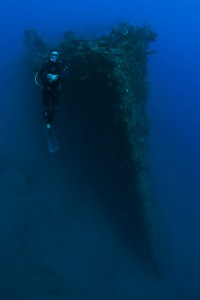
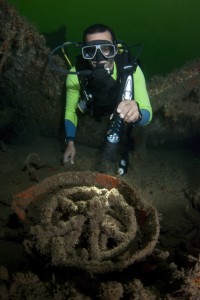 My initial head dunk underwater confirmed my concerns. I could see horizontally about 1 to 2 metres at best. But I should have put more faith in Edgar who had been diving on the wreck for more than 15 years. When we reached a depth of about 6 metres the sediment cloud dispersed leaving clear blue water. I followed Edgar over the stern and down the port side. The ship was facing directly out to sea, which seemed a strange position – I would have thought that Captain Moreu would have run aground bow first. Edgar said that the ship had probably been turned around during salvage attempts.
My initial head dunk underwater confirmed my concerns. I could see horizontally about 1 to 2 metres at best. But I should have put more faith in Edgar who had been diving on the wreck for more than 15 years. When we reached a depth of about 6 metres the sediment cloud dispersed leaving clear blue water. I followed Edgar over the stern and down the port side. The ship was facing directly out to sea, which seemed a strange position – I would have thought that Captain Moreu would have run aground bow first. Edgar said that the ship had probably been turned around during salvage attempts.
Edgar guided me to a hold full of ammunition. The bullets were held in cartridges of 5 or maybe 6. There were literally thousands of brass cases lying about. The tour continued past the funnel and on towards the bow. We stopped by one of the side-mounted 6 inch deck guns covered in coral growth. This ship must have been quite a sight during its heyday. I followed the curvature of the bow down to the seabed at 30 metres. I knelt in the sand (warily watching 3 Lionfish closing in on me) and put my camera lens on the widest possible setting for a picture.
We crossed over to the starboard side where there was a mass of mangled super structure lying on the seabed. Edgar rummaged around in the sand and pulled out a Brass Lantern still pretty much intact. This had obviously been hidden for safe keeping. I’m sure there were plenty of other artefacts waiting to be discovered inside the wreck. I circumnavigated the outside and explored most of the upper deck area. I spotted a number of entry points for some deeper penetration, but unfortunately we ran out of time.
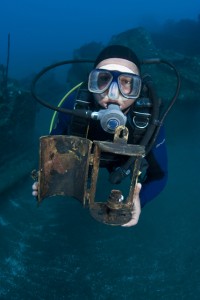
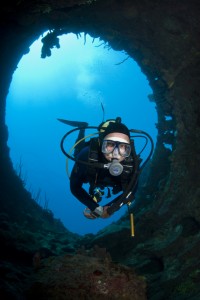 In a matter of hours the Battle of Santiago was over. The Spanish Caribbean Squadron had been completely destroyed. 6 ships had been sunk or scuttled, 474 men were either dead or injured and 1,800 men had been captured. A number of American ships had been damaged, but none were actually sunk, and only 1 US seaman was reported dead.
In a matter of hours the Battle of Santiago was over. The Spanish Caribbean Squadron had been completely destroyed. 6 ships had been sunk or scuttled, 474 men were either dead or injured and 1,800 men had been captured. A number of American ships had been damaged, but none were actually sunk, and only 1 US seaman was reported dead.
I’m not sure this trip would be suitable for die-hard wreck fanatics (although combined with the modern day shipwrecks it might work?). They are not that deep and penetration is limited. I would say it’s better suited for divers with some spirit of adventure that like historical wrecks and don’t mind travelling slightly off the beaten track. There are no other divers or dive boats operating in the area.
Before leaving Santiago de Cuba I made a visit to UNESCO site Castillo de San Pedro de la Roca, located at the entrance to Santiago Bay. Looking down from the ramparts I wondered what it must have felt like to see the whole battle raging below. I sat and watched the lowering of the flag ceremony as the sun dipped below the horizon. A Cannon fired a single salvo out to sea marking the end of another memorable day.
Gear News
Scubapro Free Octopus Promotion 2024

Free Octopus with every purchase of a SCUBAPRO regulator system
Just in time for the spring season, divers can save money with the FREE OCTOPUS SPRING PROMOTION! Until July 31st SCUBAPRO offers an Octopus for free
with every purchase of a regulator system!
Get a free S270 OCTOPUS with purchase of these combinations:
MK25 EVO or MK19 EVO with A700
MK25 EVO or MK19 EVO with S620Ti
MK25 EVO or MK19 EVO with D420
MK25 EVO Din mit S620Ti-X
Get a free R105 OCTOPUS with purchase of the following combinations:
MK25 EVO or MK19 EVO with G260
MK25 EVO or MK17 EVO with S600
SCUBAPRO offers a 30-year first owner warranty on all regulators, with a revision period of two years or 100 dives. All SCUBAPRO regulators are of course certified according to the new European test standard EN250-2014.
Available at participating SCUBAPRO dealers. Promotion may not be available in all regions. Find an authorized SCUBAPRO Dealer at scubapro.com.
More information available on www.scubapro.com.
Blogs
Northern Red Sea Reefs and Wrecks Trip Report, Part 3: The Mighty Thistlegorm

Jake Davies boards Ghazala Explorer for an unforgettable Red Sea diving experience…
Overnight, the wind picked up, making the planned morning dive a bit bumpy on the Zodiacs to the drop point on Thomas Reef. There, we would dive along the reef before descending through the canyon and then passing under the arch before ascending the wall with a gentle drift. The site provided great encounters with more pelagic species, including shoals of large barracuda, tuna, and bigeye trevally.
Once back on the boat, it was time to get everything tied down again as we would head back south. This time, with the wind behind us, heading to Ras Mohammed to dive Jackfish Alley for another great gentle drift wall dive before then heading up the coast towards the Gulf of Suez to moor up at the wreck of the Thistlegorm. This being the highlight wreck dive of the trip and for many onboard, including myself, it was the first time diving this iconic wreck. I had heard so much about the wreck from friends, and globally, this is a must on any diver’s list. Fortunately for us, there was only one other boat at the site, which was a rarity. A great briefing was delivered by Ahmed, who provided a detailed background about the wreck’s history along with all the required safety information as the currents and visibility at the site can be variable.

Kitting up, there was a lot of excitement on deck before entering the water and heading down the shoreline. Descending to the wreck, there was a light northerly current which reduced the visibility, making it feel more like the conditions that can be found off the Welsh coast. At 10m from the bottom, the outline of the wreck appeared as we reached the area of the wreck which had been bombed, as our mooring line was attached to part of the propeller shaft. Arriving on deck, instantly everywhere you looked there were many of the supplies which the ship was carrying, including Bren Carrier tanks and projectiles that instantly stood out.

We headed around the exterior, taking a look at the large propeller and guns mounted on deck before entering the wreck on the port side to take a look in the holds. It was incredible to see all the trucks, Norton 16H, and BSA motorcycles still perfectly stacked within, providing a real snapshot in time.

Overall, we had four dives on the Thistlegorm, where for all of the dives we were the only group in the water, and at times, there were just three of us on the whole wreck, which made it even more special, especially knowing that most days the wreck has hundreds of divers. Along with the history of the wreck, there was plenty of marine life on the wreck and around, from big green turtles to batfish, along with shoals of mackerel being hunted by trevally. Some unforgettable dives.

The final leg of the trip saw us cross back over the Suez Canal to the Gobal Islands where we planned to stay the night and do three dives at the Dolphin House for the potential of sharing the dive with dolphins. The site, which included a channel that was teeming with reef fish, especially large numbers of goatfish that swam in large shoals along the edge of the reef. These were nice relaxing dives to end the week. Unfortunately, the dolphins didn’t show up, which was okay as like all marine life they are difficult to predict and you can’t guarantee what’s going to be seen. With the last dive complete, we headed back to port for the final night where it was time to clean all the kit and pack before the departure flight the next day.

The whole week from start to finish on Ghazala Explorer was amazing; the boat had all the facilities you need for a comfortable week aboard. The crew were always there to help throughout the day and the chefs providing top quality food which was required after every dive. The itinerary providing some of the best diving with a nice mixture of wreck and reef dives. I would recommend the trip to anyone, whether it’s your first Red Sea liveaboard in the Red Sea or you’re revisiting. Hopefully, it’s not too long before I head back to explore more of the Red Sea onboard Ghazala Explorer.

To find out more about the Northern Red Sea reef and wrecks itineraries aboard Ghazala Explorer, or to book, contact Scuba Travel now:
Email: dive@scubatravel.com
Tel: +44 (0)1483 411590
Photos: Jake Davies / Avalon.Red
-

 News3 months ago
News3 months agoHone your underwater photography skills with Alphamarine Photography at Red Sea Diving Safari in March
-

 News3 months ago
News3 months agoCapturing Critters in Lembeh Underwater Photography Workshop 2024: Event Roundup
-

 Marine Life & Conservation Blogs2 months ago
Marine Life & Conservation Blogs2 months agoCreature Feature: Swell Sharks
-

 Blogs2 months ago
Blogs2 months agoMurex Resorts: Passport to Paradise!
-

 Blogs2 months ago
Blogs2 months agoDiver Discovering Whale Skeletons Beneath Ice Judged World’s Best Underwater Photograph
-

 Gear Reviews3 months ago
Gear Reviews3 months agoGear Review: Oceanic+ Dive Housing for iPhone
-

 Marine Life & Conservation2 months ago
Marine Life & Conservation2 months agoSave the Manatee Club launches brand new webcams at Silver Springs State Park, Florida
-

 News3 months ago
News3 months agoWorld’s Best Underwater Photographers Unveil Breathtaking Images at World Shootout 2023


